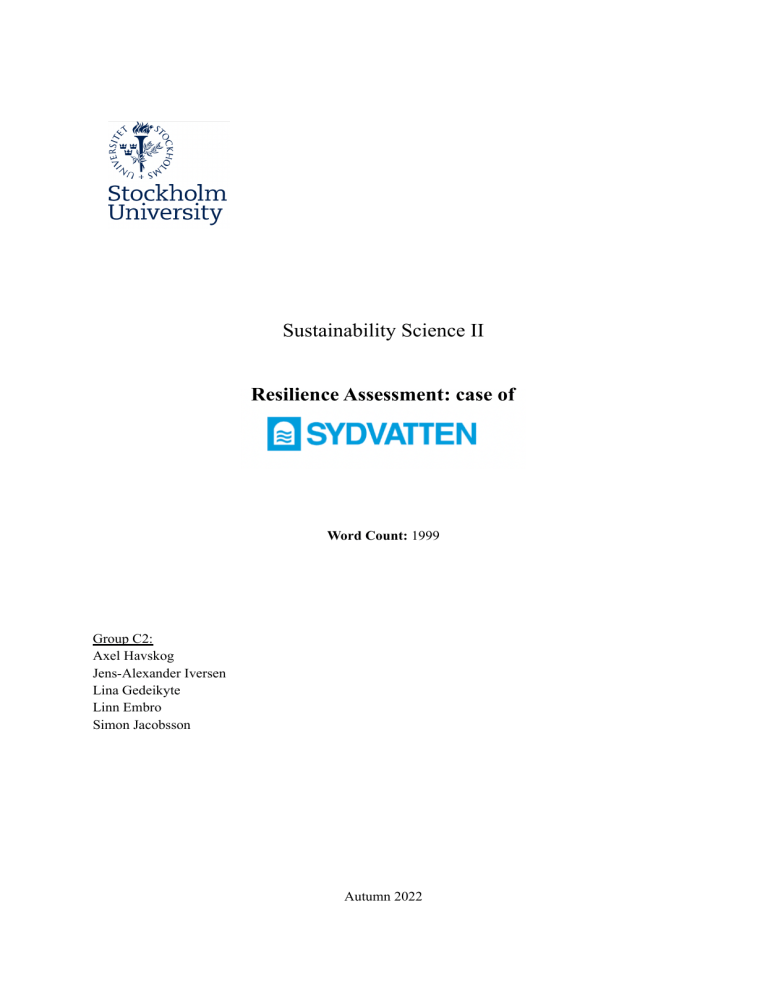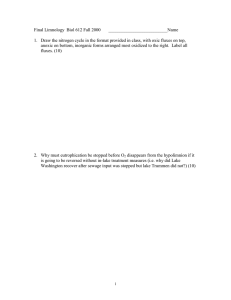
Sustainability Science II Resilience Assessment: case of Word Count: 1999 Group C2: Axel Havskog Jens-Alexander Iversen Lina Gedeikyte Linn Embro Simon Jacobsson Autumn 2022 1. Sydvatten AB system description Figure 1: Sydvatten system graph 1.1. System boundaries Resilience of what? The freshwater lakes Resilience for what? Freshwater eutrophication Resilience for whom? Sydvatten and its consumers Spatial boundaries Sydvatten is a Swedish water distributor operating within 17 municipalities in Skåne and is co-owned by all 17 municipalities. Approximately 1 million people in Skåne depend on Sydvatten for their water. Sydvatten primarily sources their water from lakes Bolmen and Vombsjön, whilst also relying on Ringsjön as a reserve-lake for emergencies. The water from Bolmen and Vombsjön is transferred to the waterworks of Ringsjöverket and Vombverket (see fig 1.). However, Bolmen is located in the region of Småland and is connected to the waterworks through an 80 km long tunnel, Bolmentunneln. Furthermore, Sydvatten is planning to expand operations to Sveadal and Skurup municipalities in Skåne (Sydvatten, 2021). 1 Temporal Boundaries & Sustainability Goals Sydvatten was established in 1966 as a response to water scarcity in Skåne (see section 2.2). Sydvatten’s strategic planning stretches 25-30 years in advance to be able to handle future challenges such as freshwater eutrophication (Prepas & Charette, 2003). However, many of Sydvatten's sustainability aspirations are time-bound goals with the main aim being to achieve carbon neutrality by 2030. To achieve this, Sydvatten focuses on using renewable energy and reducing GHG emissions (Sydvatten, 2020). Another essential goal is to decrease the chemical usage in their water purification, which could be done by investing in R&D to increase the effectiveness of chemicals (Sydvatten, 2021). Administrative boundaries Since water is a crucial resource for economic development and social progression (Zhang et al, 2022), its distribution to society is regulated by legislations and regulations. Laws exist along Sydvatten's whole value chain, including limitations of water extraction, distribution, and testing of water quality and nutrients (Regler Om Dricksvatten, 2022). Moreover, a new security Act (Säkerhetsskyddslag, 2018) has been adopted to increase safety and resilience of these operations (Sydvatten, 2021). Consequently, there are administrative constraints on how Sydvatten manages and executes its operations within certain boundaries. Key sustainability challenges and drivers The primary sustainability challenge relevant to Sydvatten is eutrophication of freshwater lakes, since this can compromise the quality and resilience of the freshwater lakes that Sydvatten depends on (Freshwater Eutrophication, 2017). Eutrophication occurs when there is an excess of nutrient input in a lake, mainly caused by fertilizer runoff from agriculture (Carpenter et al., 1999) which is further exacerbated by global warming (Causes of Climate Change, n.d.). When the levels of nutrient inputs into the lake exceeds the absorptive capacity of the rooted plants, a regime shift can occur where lakes turn from clear-water to an algae-dominated water configuration, as illustrated in figure 2 below (Biggs et al, 115). Eutrophication affects Sydvatten because it implies inferior water-quality and leads to costly purification processes (Carpenter et al., 1999). 2 Figure 2: Eutrophication basin of attraction model 3 1.2. A conceptual model of the business case as a social-ecological system (SES) Figure 3: ES bundle flower diagram The ES bundle diagram effectively represents the extent of ecosystem services (ES’) Sydvatten depends on. Freshwater, a provisioning ES, is an integral part of Sydvatten's operations. Sydvatten approximately produces 78 million cubic meters of water annually, and 4 2,500 liters every second (Work Processes, 2021). Another essential provisioning ES that enables the company to operate is raw materials used for infrastructure, purification, and maintenance. Furthermore, there are supporting and regulating ES’ essential for the provisioning of freshwater and Sydvattens operations. Catchment areas and biodiversity maintenance is crucial to reduce fertilizer runoff and nutrient accumulation in lakes, enhancing water quality. (Eutrophication, n.d.). Additionally, Sydvatten relies on the hydrological cycle and climate regulation as these are crucial supporting ES’ for the maintenance of lakes. It is assumed that Sydvatten relies heavily on some cultural ES’s that their lakes provide. Research of their lakes benefit Sydvatten as they are able to use knowledge accumulated for research and development to enhance the resilience of the lakes. Sydvatten’s infrastructure also impacts certain cultural ES’s the lakes and surrounding environments provide, such as recreational activities. In addition, Sydvattens’ operations impact provisioning and supporting/regulating services, such as the freshwater quality and biodiversity due to excavation works in the short-term such as the Bolmentunneln construction (EIS, 2020). The lakes are affected by other external key actor groups operating across different scales. On a regional scale, agriculture in the near-vicinities of the lakes can negatively affect the system through fertilizer use that might runoff into the lakes. Locally within the municipalities that Sydvatten operates in, the inhabitants' activities may impact the lakes by disrupting biodiversity. The actions of these external key actor groups may compromise the resilience of the lakes, however with proper management and cooperation, they also have the potential to enhance resilience. (Work Processes, 2021). 5 1.3 Timeline 6 7 Figure 4: Sydvatten timeline 8 2. Resilience Assessment 2.1 Causal Loop Diagram (CLD) Figure 5: Sydvatten CLD This CLD reveals interactions and feedback loops relating to Sydvatten and the lakes the company withdraws water from. Eutrophication is caused by various key drivers, mainly farms that cause fertilizer run-off into the lakes. This leads to an increase in algal blooms, blocking sunlight and increasing the water temperature as the algae absorbs and blocks sunlight from reaching the rooted plants of the lakes, promoting more blooms whilst decreasing biodiversity. The loss in biodiversity allows nutrients that have been trapped in sediments on the lake floor to become loose, which further exacerbates the growth of algae. This represents a reinforcing feedback loop as the thresholds of concern are reached, trapping an undesirable state of the system (Schlüter et al., 2015, 115). In continuation, eutrophication accelerates a decrease in freshwater quality and availability, forcing Sydvatten to increase its already expensive chemical usage. Consequently, a decrease in profits results in less money available to be invested in R&D. 9 The resultant lack of novel knowledge and development may prevent the possibility of combatting the extensive eutrophication of the lakes, which reinforces the eutrophication process (Sydvatten, 2021). It is vital that Sydvatten manages the regulation of ecosystem services related to nutrient retention in their lake catchments to enhance the resilience of the lakes. This must be done soon to prevent their lakes from reaching thresholds and tipping points that would result in undesirable regime shifts that would be difficult or impossible to reverse. 2.2. The Adaptive Cycle Figure 6: Sydvatten adaptive cycle The adaptive cycle is a useful concept to include in this assessment. As seen in figure 6, during the middle of the 1900’s, municipalities in Skåne faced population growth challenges and freshwater availability was scarce, leading to a "collapse" in Skåne’s water system (SKÅNES VATTEN, n.d.). Consequently, the Swedish government led an extensive investigation in Skåne’s water systems and concluded that Skåne’s new water distribution should mainly be extracted from lake Bolmen. This initiative led to a reorganization of the water systems through the creation of Sydvatten AB in 1966 (SKÅNES VATTEN, n.d.). 10 After the creation of Sydvatten, the corporation entered into a growth phase during 1975-2012. The Bolmentunnel was constructed in 1975 and put into use in 1987. Furthermore, 11 new municipalities joined Sydvatten, leading to a spatial expansion and an extensive increase of people relying on the corporation for their water (Sydvatten, 2015). Recently, this rapid expansion has been replaced by a stable and cautious development. The growth phase has shifted into a conservation phase, with increased focus on sustainability, and efficiency, through collaborations with universities such as Lund’s University (Work Processes, 2021). 2.3 Managing Resilience Principles Managing slow variables and feedbacks: The resilience of desired SES configurations that Sydvattens lakes produce are at risk of eroding as there is missing feedbacks from the system to the key factors driving the changes in the SES, such as fertilizer runoff from farmers, which is depicted in the CLD. Management is needed beyond the boundaries of Sydvattens lakes at the catchment scale in order to reduce fertilizer runoff into the lakes. The local agricultural practices directly impact the lakes. However, since the farms are not in close proximity to the lakes, the farmers often use alternative water sources for their operations, hence are not affected by the consequences of agriculture on the lakes. This lack of feedback requires that incentive-based feedbacks are created to establish a connection from the eutrophication of the lakes to the farmers. One such method would be introducing compensation or reward-schemes for sustainable agricultural operations, such as enhancing nutrient retention in the landscape. Such methods include: enhancing vegetation of hills, stubble on fields, as well as maintaining wetlands and riparian areas (Biggs et al, 126) Overall, these compensation schemes would widen the systems’ boundaries by internalizing key drivers of eutrophication of Sydvatten’s lakes, such as local farming, and building and strengthening feedbacks between the lake systems and farmers. Sydvatten could cooperate with the Swedish government to implement these incentive programmes in order to limit financial burden. 11 2.4 Concluding Assessment In conclusion, the eutrophication of freshwater lakes is a threat for Sydvatten. The CLDs have shown that there are reinforcing feedbacks of eutrophication and the adaptive cycle suggests that the next phase is the collapse phase. Thus Sydvatten has to focus on adapting and transforming as a company in order to enhance the resilience of the lakes in which they rely on. Adaptation and transformation will be appropriate trajectories for Sydvatten since the company needs to adapt aspects of their business plan and implement strategic planning to transform the eutrophication development trajectory. This could be done by adapting Sydvatten's strategic planning to include more extensive scenario-planning and risk-calculation to improve foresight capabilities (Natale et al., 2022). Moreover, Sydvatten must transform features of their operation to include external actors to combat the forces driving eutrophication of their lakes such as incentive schemes for farmers. To achieve this, Sydvatten must transform their mindset to a more holistic view where factors beyond the scope of their internal operations are managed. Whilst persistence has its benefits, we believe that it is not as suitable for Sydvatten since tipping points and regime shifts of eutrophication may occur if deliberate action is not taken soon. This would lead to difficulties in recovering/reversing the undesirable regime shift, which they would try to counteract through extensive research, time and resources, posing a greater burden on Sydvatten (Biggs et al., 2015, 115). 3. Discussion One key insight that has been attained by working on this resilience assessment is the importance of strategies or laws for regulating the key drivers and feedbacks of eutrophication. Since there is a lack of feedback of Sydvatten’s lakes to key drivers, implementing incentives for farmers to reduce fertilizer runoff is crucial to establish these feedback links. Another pivotal understanding is the importance of implementing principles to enhance resilience and that many of these resilience principles overlap. For instance, managing slow variables and feedbacks through cooperating with governmental agencies would foster resilience through multiple manners. Such cooperation encourages learning by integrating 12 knowledge on multiple levels, and through broadening participation and interactions between scales. Overall these factors promote polycentric governance and are all crucial principles for building resilience for Sydvatten. A strength of this assessment is that the system and challenge of eutrophication has been viewed and analyzed as a whole rather than as individual components, which fosters complex adaptive systems thinking. This helped us identify obscured drivers, interactions, feedbacks, and dynamics more easily, therefore achieving a more holistic understanding of the system. Had we analyzed the system as individual components, it would have been challenging to comprehend the interconnectedness of the system dynamics as a whole and to find sustainable solutions. One aspect that would further advance this assessment is assessing how Sydvatten implements the resilience principles which we did not extensively research. This includes how they as a company maintain diversity and redundancy of their lakes and manage connectivity. It would also be useful to evaluate how the culture and organization of the company fosters complex adaptive systems thinking. 13 4.0 Bibliography Application for a permit for water operations and civil engineering works in the Natura 2000 site Klingavälsån. (2020, October 9). European Investment Bank. Retrieved November 19, 2022, from https://www.eib.org/attachments/registers/160335622.pdf Biggs, R., Schlüter, M., & Schoon, M. L. (Eds.). (2015). Principles for Building Resilience: Sustaining Ecosystem Services in Social-Ecological Systems. Cambridge University Press. Carpenter, S. R., Ludwig, D., & Brock, W. A. (1999). Management of Eutrophication for Lakes Subject to Potentially Irreversible Change. Ecological Applications, Vol .9, pp. 751-771. https://www.jstor.org/stable/2641327 Causes of climate change. (n.d.). Language selection | Climate Action. Retrieved December 6, 2022, from https://climate.ec.europa.eu/climate-change/causes-climate-change_en Eutrophication. (n.d.). The Open University. Retrieved November 19, 2022, from https://www.open.edu/openlearn/nature-environment/environmental-studies/eutrophication/co ntent-section-4.4.3 Exjobbsförslag våren 2021: Assessment of groundwater distribution to Swedens twelfth largest lake. (2021). Sweden Water Research. Retrieved November 28, 2022, from https://www.swedenwaterresearch.se/exjobb/exjobbsforslag-varen-2021-assessment-of-groun dwater-distribution-to-swedens-twelfth-largest-lake/ Freshwater Eutrophication. (2017, January 23). Regime Shifts DataBase. Retrieved November 19, 2022, from https://regimeshifts.org/component/k2/item/55-freshwater-eutrophication Lele, S., Spingate-Baginski, O., Lakerveld, R., Deb, D., & Dash, P. (2013). Ecosystem Services: Origins, Contributions, Pitfalls, and Alternatives. Conservation & Society, Vol. 11, pp. 343-358. JSTOR. Retrieved 11 19, 2022, from https://www.jstor.org/stable/26393131 Natale, A., Poppensieker, T., & Thun, M. (2022, 03 9). From Risk Management to Strategic resilience. McKinsley & Company. Prepas, E. E., & Charette, T. (2003). Worldwide Eutrophication of Water Bodies: Causes, Concerns, Controls. Treatise on Geochemistry, Volume 9, 311-331. Science Direct. doi:10.1016/B0-08-043751-6/09169-6 14 Regler om dricksvatten. (2022, 11). Livsmedelsverket. Retrieved November 19, 2022, from https://www.livsmedelsverket.se/foretagande-regler-kontroll/dricksvattenproduktion/regler-o m-dricksvatten Säkerhetsskyddslag (2018:585) Svensk författningssamling 2018:2018:585 t.o.m. SFS 2022:443. (2018, May 24). Riksdagen. Retrieved December 5, 2022, from https://www.riksdagen.se/sv/dokument-lagar/dokument/svensk-forfattningssamling/sakerhets skyddslag-2018585_sfs-2018-585 SKÅNES VATTEN. (n.d.). Sydvatten. Retrieved December 5, 2022, from https://sydvatten.se/app/uploads/2018/05/Sydvatten-Arsredovisning-2016.pdf Sydvatten. (2015, June 18). Vårt uppdrag – Sydvatten. Sydvatten. Retrieved December 5, 2022, from https://sydvatten.se/om-sydvatten/vart-uppdrag/ Sydvatten. (2020). Klimatbokslut. www.sydvatten.se. Retrieved 11 19, 2022, from https://sydvatten.se/app/uploads/2021/04/Klimatbokslut_2020_Sydvatten.pdf Sydvatten. (2021). HÅLLBARHETS- OCH ÅRSREDOVISNING. www.sydvatten.se. Retrieved 11 19, 2022, from https://sydvatten.se/app/uploads/2022/04/Hallbarhets-och-arsredovisning-2021.pdf Work Processes. (2021, 11). Sydvatten. Retrieved November 19, 2022, from https://sydvatten.se/app/uploads/2021/11/Verksprocesser_eng_LU_web_nov-2021.pdf Zhang, F., Wu, Z., Di, D., Jiang, M., Wang, H., & Chen, X. (2022). Social values of water resources: Analyzing its spatial distribution characteristics and influencing factors using an ESSR model. Ecological Indicators, Volume 142. Science Direct. doi.org/10.1016/j.ecolind.2022.109200 15






